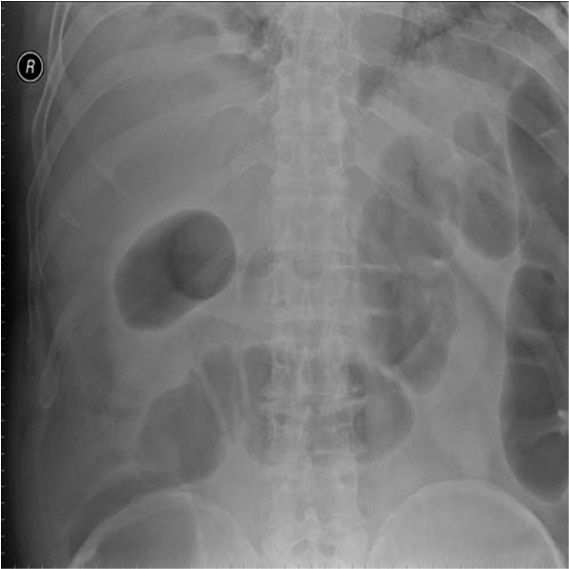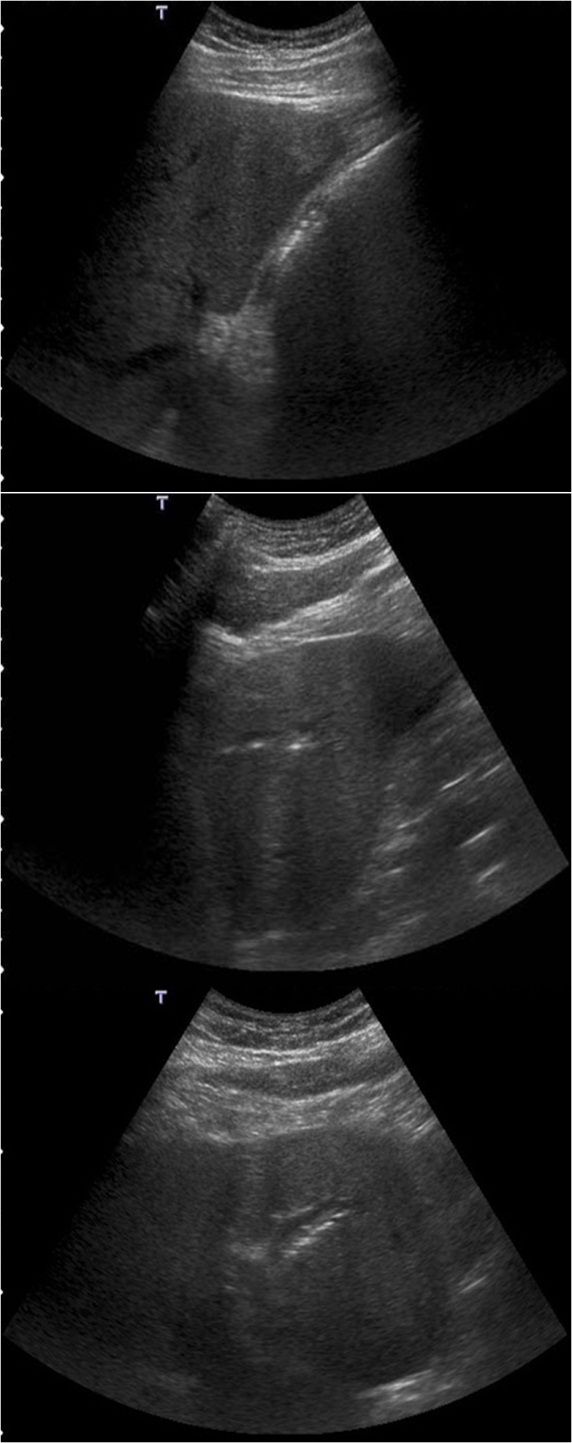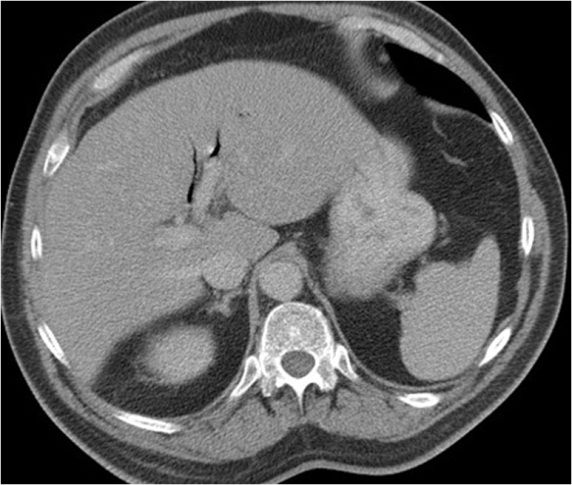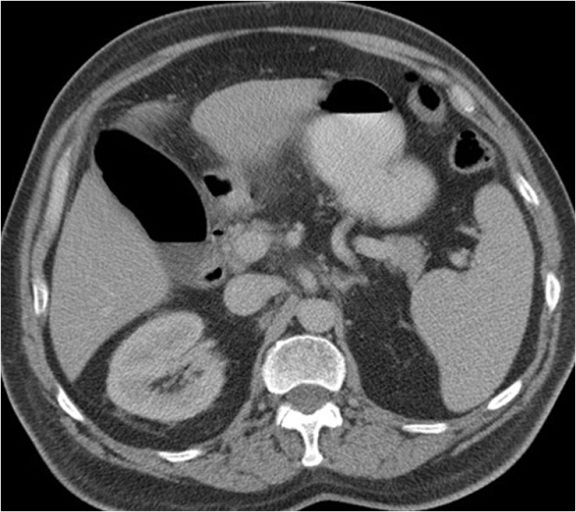Gangrenous Cholecystitis
A 69-year-old male patient presented with a three-week history of right upper quadrant abdominal pain, pyrexia.
Clinical History: A 69-year-old male patient presented with a three-week history of right upper quadrant abdominal pain, pyrexia.

Plain X-Ray of the abdomen shows gas-filled structure in the right upper quadrant, most likely air filled gall bladder; for clinical correlation and further investigation.

Ultrasound shows the gallbladder is not fluid-filled and appears filled with air showing posterior shadowing. Some air in IHBR.

CT confirms the findings on plain film and ultrasound. CT images show gallbladder is filled with air and minimal fluid. Air in intra hepatic ducts represents gangrenous cholecystitis.

CT confirms the findings on plain film and ultrasound. CT images show gallbladder is filled with air and minimal fluid. Air in intra hepatic ducts represents gangrenous cholecystitis.
Diagnosis: Gangrenous cholecystitis
Discussion: Gangrenous cholecystitis (GC) is a serious complication of acute cholecystitis. It is the result of marked distension of the gallbladder causing increased tension in the gallbladder wall. Associated inflammation leads to ischemic necrosis of the wall, with or without associated cystic artery thrombosis.
It is more common in men and in patients with co-existing cardiovascular disease and leukocytosis - white cell count (WCC) greater than 17 × 109/L. Other associated factors include diabetes, critical illness and a high C-reactive protein (CRP) level. Pre-operative diagnosis of this condition may prove difficult. Once suspected, patients with GC generally undergo emergency cholecystectomy in order to avoid life-threatening complications.
GC is the last stage of gallbladder inflammation and, in spite of its grave prognosis, its diagnosis can be elusive, both clinically and on laboratory investigation. The incidence of GC ranges from 2 percent to 29.6 percent in all patients with acute cholecystitis, in various surgical series, and generally occurs in older patients. Many factors have been implicated in its formation. Fagan et al. demonstrated that nine variables were associated with GC, but Contini et al. showed that there is no single clinical or laboratory finding, apart from a high WCC, predictive of severe inflammation of the gallbladder.
Contini et al. showed that the time of hospitalization delay plays a crucial role in the formation of GC. The time between the onset of symptoms and hospital admission was significantly longer in patients with GC. The patient's history (timely or delayed admission) and physician's attitude (general practitioner and/or surgeon) are likely to play a role in the progression towards a severe necrosis of the gallbladder wall.
Ultrasonography usually serves as the first-line imaging modality for the evaluation of patients with clinically suspected acute cholecystitis. However, CT can play an important role in evaluation of these patients if sonography is inconclusive. The hallmark on sonography of GC is the presence of heterogeneous or striated thickening of the gallbladder wall, which is often irregular with projections into the lumen and pericholecystic fluid collections. The presence of intra-luminal membranes representing desquamative gallbladder mucosa is a specific finding but it is less common. The accuracy of pre-operative ultrasound in diagnosing GC remains uncertain. Twenty-eight percent of patients with GC had ultrasound reports that failed to show any evidence of acute inflammation. This was mainly due to the absence of sonographic Murphy's sign and gallbladder walls of less than 3 mm, both important radiological signs of acute inflammation of the gall bladder.
The CT findings most specific for acute GC are gas in the wall or lumen, intra-luminal membranes, an irregular wall and pericholecystic abscess. GC is associated with a lack of mural enhancement, pericholecystic fluid and a greater degree of gallbladder distension and wall thickening. GC has a mortality rate of up to 22 percent and a complication rate of 16 percent to 25 percent. Complications associated with GC include perforation, which has been reported to occur in as many as 10 percent of cases of acute cholecystitis. Perforation of the gall bladder can then lead to abscess formation or peritonitis. Hence, in contrast to acute cholecystitis, it is important both to diagnose and surgically treat GC prior to complication and/or perforation to avoid its high morbidity and mortality rate.
Conclusion: When dealing with patients with acute cholecystitis, a high index of suspicion is essential for the early diagnosis and treatment of GC. The possibility of a patient, especially an elderly patient with acute cholecystitis, progressing to GC should always considered, even in an apparently improving patient and in spite of the absence of any firm clinical or laboratory findings. The radiological investigations may not be conclusive. There is a need for an early (if not urgent) surgical intervention in acute cholecystitis (whether laparoscopic or open surgery) in order to decrease the time elapsed from the start of symptoms to admission and treatment.
References:
http://www.jmedicalcasereports.com/content/5/1/199http://www.ajronline.org/content/178/2/275http://www.belsurg.org/uploaded_pdfs/106/106_545_549.pdfhttp://radiology.rsna.org/content/148/1/219.full.pdf+html
Sushila Ladumor, MD, FRCR, consultant radiologist with multi-modality imaging experience, working in Medical Imaging Department, King Abdulaziz Medical City, Riyadh, Saudi Arabia.
Could AI-Powered Abbreviated MRI Reinvent Detection for Structural Abnormalities of the Knee?
April 24th 2025Employing deep learning image reconstruction, parallel imaging and multi-slice acceleration in a sub-five-minute 3T knee MRI, researchers noted 100 percent sensitivity and 99 percent specificity for anterior cruciate ligament (ACL) tears.
The Reading Room Podcast: Current Perspectives on the Updated Appropriate Use Criteria for Brain PET
March 18th 2025In a new podcast, Satoshi Minoshima, M.D., Ph.D., and James Williams, Ph.D., share their insights on the recently updated appropriate use criteria for amyloid PET and tau PET in patients with mild cognitive impairment.